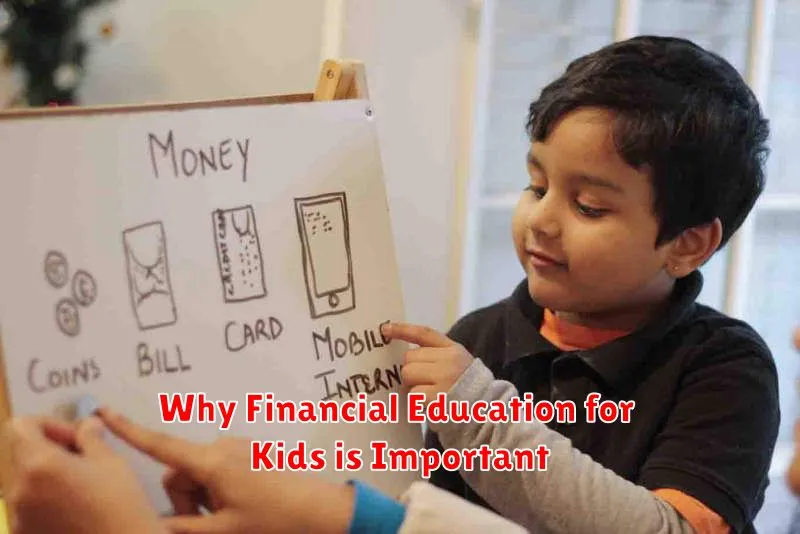Teaching kids about money from a young age is one of the most valuable gifts you can give them. It equips them with essential financial literacy skills that will serve them throughout their lives, setting them up for financial security and success. But when and how do you start? This guide breaks down age-appropriate money lessons and practical tips to make learning about finances fun and engaging for your children.
From understanding the value of a dollar to learning about saving, spending, and even investing, we’ll cover it all. Whether you’re the parent of a toddler or a teenager, you’ll find actionable advice to empower your kids to become money-smart individuals. Let’s embark on this journey together and raise a generation that’s financially savvy and responsible.
Why Financial Education for Kids is Important

Teaching kids about money is about more than just dollars and cents—it’s about setting them up for a lifetime of financial well-being. Financial education empowers children with the knowledge, skills, and habits they need to make smart financial decisions as they grow.
When kids understand the value of money, they learn to manage their resources, delay gratification, and work towards goals. These are crucial life skills that extend far beyond personal finance, impacting their education, careers, and overall decision-making.
By introducing financial concepts early on, parents can help their children avoid common financial pitfalls, build a strong financial foundation, and achieve their dreams.
Age-Appropriate Financial Lessons for Kids
Teaching kids about money from a young age is crucial for building a strong financial foundation. But, it’s important to tailor those money lessons to their level of understanding. Here’s a breakdown of age-appropriate financial concepts:
Preschool (Ages 3-5)
At this age, kids learn best through play. Introduce basic concepts like:
- Needs vs. Wants: Explain the difference between things we need (food, shelter) and things we want (toys, candy).
- Saving: Use a clear jar to save for a small toy, teaching them about delayed gratification.
- The Value of Money: Show them that money is used to buy things.
Elementary School (Ages 6-10)
As kids enter school, they can grasp more complex ideas:
- Earning Money: Introduce age-appropriate chores to earn an allowance, teaching the connection between work and income.
- Budgeting: Help them divide their allowance into spending, saving, and maybe even sharing (donations).
- Smart Spending: Start comparing prices at the store to understand the concept of value.
Middle School (Ages 11-13)
Preteens are ready for more financial responsibility:
- Banking: Consider opening a savings account in their name to teach them about banking basics (deposits, interest).
- Online Safety: Discuss online shopping safety and responsible online behavior.
- Delayed Gratification: Encourage saving for larger purchases, teaching patience and planning.
High School (Ages 14-18)
Prepare teenagers for real-world financial independence:
- Part-Time Jobs: Encourage them to get a part-time job to manage their own money and learn about taxes.
- Budgeting Apps: Introduce budgeting apps to help them track spending and income.
- Investing: Explain basic investment concepts like stocks and bonds (consider a small custodial account).
- Credit Cards and Debt: Discuss responsible credit card use and the dangers of debt.
By adapting financial lessons to your children’s ages and understanding, you can set them on a path to becoming financially responsible adults.
Fun and Interactive Ways to Teach Kids About Money
Teaching kids about money doesn’t have to be boring! Make it fun and engaging with these interactive activities:
1. Play “Grocery Store” or “Restaurant”: Set up a pretend store with priced items. Let your child be the cashier or the customer, practicing counting money and making change.
2. Start a Savings Jar Challenge: Decorate jars for different savings goals (e.g., a toy, a trip). Encourage saving by turning it into a visual and tangible experience.
3. Use Money-Related Board Games: Games like Monopoly or PayDay introduce financial concepts like buying, selling, and budgeting in a playful way.
4. Introduce Allowance & Chores: Tie an allowance to age-appropriate chores to teach the connection between work and earning money.
5. Explore Online Resources: Websites and apps designed for kids offer interactive games and simulations to build financial literacy skills.
The Role of Allowance in Financial Education
Giving your child an allowance is a powerful tool for teaching them about financial responsibility. It provides a practical, hands-on way for kids to learn about earning, spending, saving, and even budgeting.
Regular allowance gives children the opportunity to make their own spending choices. This allows them to experience the consequences of their decisions, both positive and negative. Did they spend all their money at once and miss out on something they wanted later? This teaches valuable lessons about delayed gratification and the importance of planning ahead.
Furthermore, allowance can be tied to chores and responsibilities, helping children understand the connection between work and income. It’s crucial to establish clear expectations and guidelines for how the allowance is earned and what it can be spent on.
Teaching Kids the Value of Saving

Teaching kids the value of saving is a crucial life skill that can set them up for financial success. Start by introducing the concept of saving early on. Even young children can grasp the idea of setting aside money for something they want.
Use a clear jar or piggy bank where they can visually see their savings grow. Help them set a savings goal, whether it’s a new toy, a special outing, or a larger purchase down the line.
Turn saving into a habit. Encourage them to save a portion of their allowance or any money they receive as gifts. Consistency is key. Even small amounts saved regularly add up over time.
Introduce the concept of delayed gratification. Explain that sometimes you have to wait and save up to buy something you really want. This helps children develop patience and learn the value of planning ahead.
Consider setting up a matching program to incentivize saving. For every dollar they save, you can contribute a small amount. This teaches them the power of earning and growing their money.
Most importantly, be a positive role model. Let your children see you saving money and making responsible financial decisions. Children often learn best by observing the adults in their lives.
How to Involve Kids in Family Financial Decisions
Involving children in family financial decisions is a practical approach to teaching them about money management. By giving them a glimpse into how financial decisions are made, children can start to understand the value of money and the trade-offs involved.
Begin by discussing age-appropriate financial decisions with your children. For example, if you’re planning a family vacation, involve them in the budgeting process. Let them know how much you’re willing to spend, and encourage them to research different options and compare costs.
Another great way to involve kids is to give them an allowance and the freedom to make some spending choices. This will allow them to experience the consequences of their decisions firsthand and learn from their mistakes.
Finally, be open and honest with your children about your own financial situation. Explain the difference between needs and wants, and talk to them about your financial goals. By involving them in your family’s financial journey, you’ll help them develop essential money management skills that will serve them well throughout their lives.
Resources to Help Educate Kids About Money
Teaching kids about money can be fun and engaging with the right resources. Here are a few options to consider:
Books: Age-appropriate books can introduce basic financial concepts in an engaging way. Look for titles that cover topics like saving, spending, and earning money.
Apps and Websites: Many apps and websites offer interactive games and activities that teach kids about money management. Some popular options include Greenlight, FamZoo, and PiggyBot.
Board Games: Classic board games like Monopoly and The Game of Life can teach kids about budgeting, investing, and financial decision-making in a fun and competitive environment.
Real-Life Experiences: Providing kids with opportunities to manage their own money, such as giving them an allowance or letting them make purchases at the store, can be invaluable learning experiences.
Educational Programs: Look for workshops, seminars, or online courses designed to teach kids about money. These programs often cover topics like budgeting, saving, investing, and avoiding debt.
Remember to choose resources that align with your child’s age and interests to make learning about money enjoyable and effective.

